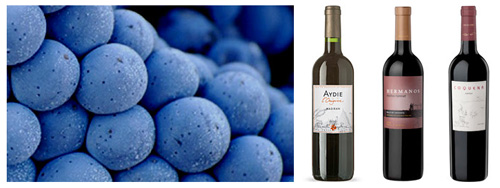| « Previous | News | Next » |
May 23, 2014
Tough, Black, and Thick-skinned...
…Tannat is the grape world’s heart of darkness. Formidable indeed, it’s named for its intense tannins, and can be a mouth-gripper if in the wrong hands. But with the right producer, the right terroir, and, often, the right blend, it can offer power and lip-smacking nuance.

Most famously, it’s the principle grape in the Madrian AOC in the south west of France. There, it’s usually softened by blending with Cabernet Franc, Cabernet Sauvignon, or Fer (Pinenc), and often sees long stretches in oak. Chateau d’Aydie is a pioneer in the region, and has been making wine since before it became an official AOC (in 1948). The domaine’s 2011 ‘L’Origine’ is a blend of 70 percent Tannat and 30 percent Cabernet Franc, grown on clay-limestone slopes with small pebbles. They ferment the grapes separately, then age 80 percent of the final blend in tank and 20 percent in oak barrels for 12 months. The resulting wine has firm, dusty tannins, and a full, floral effect. There is certainly a power to this wine, but with notes of currants, violets, spice, and soil, there’s also a prettiness.
Though generally associated with its French appellation, Tannat is from the Basque region, and made its way to South America via Basque settlers in the 19th century. The South American sun agreed with the grape, and it’s now firmly a part of the continent’s viticulture. Uruguay in particular has embraced it, but it also has a place in Argentina—especially in the Salta region. The high altitudes (highest in the winemaking world!) and intense, plentiful sunshine help make wines with focused aromas and round tannins. The Hermanos de Domingo Molinos Winery blends its Tannat (30 percent) with Malbec to make a lush, savory wine with shockwaves of flavor. Grown at 6,970 feet with 340 days of sunshine, and the benefit of pure mountain water, the grapes are able to build ample acid to balance out their ripeness. In this blend, the Tannat provides structure and precision while the Malbec contributes a plush, velvet texture. It’s full-throttled and inky black, with notes of olive, dried black fruits, smoke, and soil on the nose. The palate is expansive, with notes of licorice, cocoa powder, and spice. The acid is good here, adding a liveliness to what could be a heavy wine.
Also from Salta, the Coquena Winery makes a bold move—and a bold wine—with its 100 percent Tannat. Though it’s not short on muscle, it’s considerably more lush than you might expect. Grown at 5,576 feet, the tannins are round and the wine is rich, with aromas of coffee, dried flowers, spice, chocolate, and blackberry. The depth of flavor and downright smoothness of the texture make this wine a prime example of how the right terroir can tame the wild Tannat beast.
